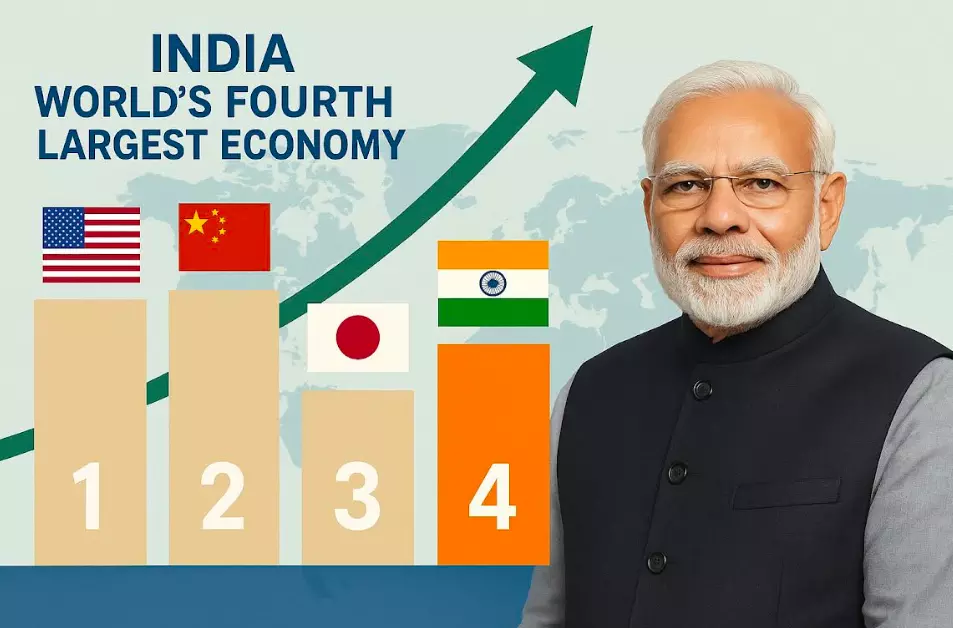Policy Shifts Make India World’s 4th Largest Economy
India's rank has steadily improved from 71 in 2014-15 to 39 in 2023-24.

India’s economic position in the world was 11th in 2014 with an economy size of 2.04 trillion in US dollars, becoming the fourth largest economy in the world with an economy size of $4.19 trillion at current prices in 2025, with an increase of over two times (Source: IMF World Economic Outlook, 2025). Now, the Indian economy is larger than Japan’s and, except for the United States, China, and Germany, no nation is currently ahead of India.
During this period, India has ranked 39th on the latest world competitiveness index list released by the International Institute for Management Development (IMD) in 2023. India's rank has steadily improved from 71 in 2014-15 to 39 in 2023-24.
During 2014-2024, India’s inflation-adjusted average growth rate was six per cent against the world’s inflation-adjusted average growth rate of 2.8 per cent (Source: World Bank National Accounts Data). If the year 2020 is excluded due to Covid-19, the average growth rate of India during this period is 7.15 per cent. If we look at the average economic growth of India for the last 10 years (from 2014 to 2024), it is 6.86 per cent.
India has become the world's fourth-largest economy not only due to its relative growth performance compared to the global growth rate, but also due to a higher economic growth rate in the last 10 years (2014-2024) compared with the preceding 10 years, i.e., 2004-14. The rise in the economic size of India during 2014-2024 is mainly due to a rise in economic activity in the manufacturing, electricity, gas, water supply, roads and railways sectors. The compound annual average growth rate (CAGR) in these activities during 2014-24 is recorded at 21 per cent in current prices compared to a CAGR of 18 per cent during 2004-2014.
One more important factor is fiscal federalism and the rise in the degree of fiscal decentralisation at the state government and local body levels after 2014. Decentralisation includes last-mile provision of critical public goods and civic services. Fiscal decentralisation has a significant impact on economic growth and a rise in size of the national economy. The Union government has significantly increased the states’ share in the net proceeds of the Union tax revenues to 42 per cent, which is a huge jump from the earlier 32 per cent, implementing the recommendations by both the 14th & 15th Central Finance Commissions. This higher fiscal devolution of untied funds to the states since 2015-16 aims to provide greater financial independence to states. This is a “compositional shift" in transfers from grants to tax devolution, making tax devolution the primary route for transferring resources to states and need-based local service delivery. Besides, the Union government has transferred resources amounting to Rs 2,87,436 crores for the period 2015-16 to 2019-2020 to urban local bodies and panchayati raj institutions (PRIs) compared to the transfer amounting to Rs 87,519 crores with an 11.5-fold rise during the period 2010-11 to 2014-15. Further, during the period 2020-21 to 2025-26, total grants transferred to local bodies amount to Rs 5,26,361 crores, an increase by a factor of 1.83. Besides, the state governments have also transferred funds to local bodies from their consolidated funds to further increase the degree of decentralisation at the local body level.
Hailed as one of the biggest tax reforms of the country, the Goods and Services Tax (GST) was introduced in 2017 with the idea of “one nation, one tax”. The benefits of GST in business processes have been instrumental in increasing the economic activities of the nation.
It is expected that India will continue to be the world’s fastest-growing major economy and is the only country expected to record over six per cent growth over the next two years. This rapid growth is expected to push India’s GDP to $5,584.476 billion by 2028 enabling it to overtake Germany and become the third-largest economy. To achieve third position, investment in urban infrastructure will play a critical role.
To conclude, over time, the size of India's economy has increased, and therefore, it has bagged the fourth position on the world GDP ranking list. As per IMF’s projections, India can become the third-largest economy in the world, as today, different government initiatives have ensured that all citizens enjoy a better quality of life.
According to the estimate of Morgan Stanley India, it will be the world's third-largest economy by 2028 as it becomes the world's most sought-after consumer market and gains share in global output, driven by macro-stability, improved policy and better infrastructure.
The author is a professor of finance at XIM University, Bhubaneswar, Odisha
Photograph: Author Dr Asit Ranjan Mohanty
